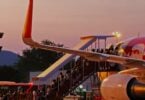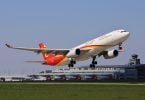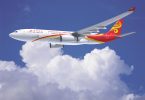WASHINGTON, DC and LONDON, England – The Business Travel Coalition (BTC) today in reacting to a little known US Congressional Research Service (CRS) report on massive government subsidies and financial aid to the US airline industry urged Washington to not lose sight of the enormous benefits of vigorous airline competition and the economic value that Open Skies, versus more restrictive aviation policies, has delivered to consumers, tourism, the US aerospace sector, cargo carriers, shippers and the US national economy.
The CRS finalized a study in 1999 that conservatively found that between 1918 and 1998 the federal government spent $155 billion dollars in support of aviation activities. The full report apparently was never published. WikiLeaks secured a copy of the full report and quietly released it in 2009.
Publisher: United States Congressional Research Service
Title: AVIATION: DIRECT FEDERAL SPENDING, 1918-1998 CRS report number: RL30050
Author(s): John W. Fischer and Robert S. Kirk, Economics Division
Date: February 3, 1999
ABSTRACT
The federal government has provided large financial resources in support of commercial aviation since 1918. This report details the amounts and types of federal spending that have occurred over this 80-year period. It also discusses some of the issues that have shaped federal policy toward aviation and identifies some of the issues likely to affect federal spending in the future.
(Access the full CRS report at http://businesstravelcoalition.com/documents/1998-crs-study.pdf.)
“A central argument of some U.S. airlines seeking government protection from foreign competition is that the Persian Gulf States have been inappropriately and unfairly helping the Gulf carriers become established with financial aid. What this report shines a bright light on is the simple fact that government assistance has long been provided on a very large scale to airlines around the world, including in the U.S.,” stated BTC Chairman Kevin Mitchell. What’s more, the U.S. Government, fully cognizant of this reality, endorsed an Open Skies policy over two decades ago that, while it provides sufficient flexibility to deal with major market distortions, is not premised on the complete absence of government aid to aviation, much less on some subjectively-perfect level playing field,” added Mitchell.
CRS REPORT QUOTES
“In the early years of federal support for aviation most assistance came in the form of designated subsidies to foster the growth of what has become the commercial aviation industry. This was in keeping with the aviation sector’s embryonic nature. As the industry has matured, the level and expense of the federal effort has expanded and spending for capital infrastructure and operational activities have become specific components of annual federal budgets.”
“In the intervening 80 years the federal government has spent $155 billion in support of aviation activities.”
“The aircraft loan guarantee program began in 1957 and expired in 1983. During its lifetime, the program authorized federal guarantees of up to 90 percent of private loans for the purchase of equipment by local, short-haul, and feeder air carriers.”
BTC observes that since the 1999 CRS report, the U.S. airline industry has benefited from billions of dollars of additional federal, state and local government subsidies and bailouts and unique structural advantages. U.S. carriers can reduce (and indeed have significantly) expenses in bankruptcy proceedings, shift pension liabilities to the Pension Benefit Guaranty Corporation, benefit from general revenues from the U.S. Treasury that flow into the Airport and Airway Trust Fund and avoid ticket taxes on billions of dollars in revenues through ancillary fees and carrier-imposed charges.
Importantly, the industry has been consolidated to the very powerful BIG 3 mega airlines and they operate in and from the largest aviation market in the world and the most important and stable country, and a country whose greenback serves as the world’s reserve currency. The list goes on and on and U.S. airlines have logically and deftly leveraged all these powerful advantages.
However, in this instance, asking the U.S. government to protect them from new foreign entrants would only help Delta, American and United – the three most profitable airlines in the world – at the expense of all manner of commercial and cargo airline consumers as well as numerous other Open Skies stakeholders.






















